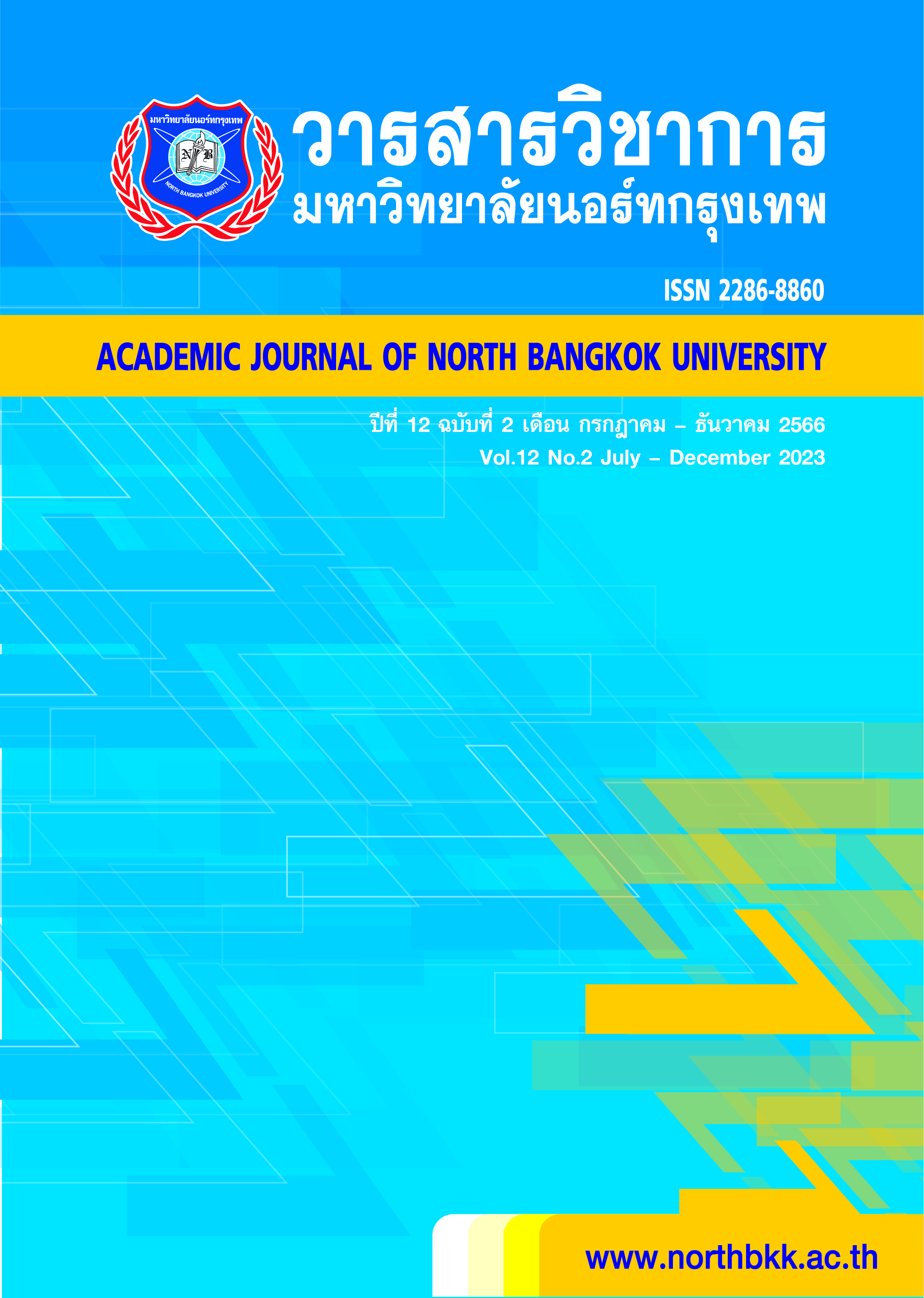อิทธิพลของการตลาดพันธมิตร การสื่อสารแบบปากต่อปากออนไลน์ และความไว้วางใจที่มีต่อความตั้งใจซื้อสินค้าออนไลน์ของผู้บริโภคในประเทศไทย
คำสำคัญ:
การตลาดพันธมิตร , การสื่อสารแบบปากต่อปากออนไลน์ , ความไว้วางใจ , ความตั้งใจซื้อสินค้าออนไลน์บทคัดย่อ
การวิจัยนี้มีวัตถุประสงค์เพื่อพัฒนารูปแบบสมการโครงสร้างระหว่างการตลาดพันธมิตร การสื่อสารแบบปากต่อปากออนไลน์ ความไว้วางใจต่อการซื้อสินค้าออนไลน์ และการตั้งใจซื้อสินค้าออนไลน์ และเพื่อตรวจสอบความสอดคล้องของรูปแบบสมการโครงสร้างระหว่างการตลาดพันธมิตร การสื่อสารแบบปากต่อปาก ความไว้วางใจต่อการซื้อสินค้าออนไลน์ และการตั้งใจซื้อสินค้าออนไลน์กับข้อมูลเชิงประจักษ์ เป็นวิธีวิจัยเชิงปริมาณ ทำการเก็บรวบรวมข้อมูลด้วยแบบสอบถามจากตัวอย่างที่เป็นผู้บริโภคที่เคยพบเห็นการโปรโมตสินค้าและบริการผ่านลิงก์พันธมิตร จำนวน 450 ราย โดยใช้วิธีการสุ่มตัวอย่างแบบหลายขั้นตอน (Multi - stage sampling) ทำการวิเคราะห์ข้อมูลโดยใช้สถิติเชิงพรรณนา และการวิเคราะห์โมเดลสมการโครงสร้าง ผลการวิจัยพบว่า รูปแบบสมการโครงสร้างการตลาดพันธมิตร การสื่อสารแบบปากต่อปากออนไลน์ และความไว้วางใจที่มีต่อความตั้งใจซื้อสินค้าออนไลน์ของผู้บริโภคในประเทศไทยมีความเหมาะสม โดยมีองค์ประกอบ (1) การตลาดพันธมิตร ประกอบด้วย การแชร์ข้อมูล การแฝงลิ้งค์ และการสร้างคุณค่า (2) การสื่อสารแบบปากต่อปาก (eWOM) ประกอบด้วย ความไว้วางใจต่อผู้ส่งข่าวสาร และประสบการณ์ที่ผ่านมาของผู้รับสาร (3) ความไว้วางใจต่อการซื้อสินค้าออนไลน์ ประกอบด้วย ความไว้วางใจในความเต็มใจช่วยเหลือ ความไว้วางใจในการเผยแพร่ข้อมูล และความไว้วางใจในผู้ขาย และ (4) ความตั้งใจซื้อออนไลน์ ประกอบด้วย ความตั้งใจในการทำธุรกรรมออนไลน์ ความตั้งใจในการซื้อซ้ำ และความตั้งใจในการแบ่งปันข้อมูลอย่างต่อเนื่อง รูปแบบสมการโครงสร้างระหว่างการตลาดพันธมิตร การสื่อสารแบบปากต่อปาก ความไว้วางใจต่อการซื้อสินค้าออนไลน์ และการตั้งใจซื้อสินค้าออนไลน์ของผู้บริโภคในประเทศไทยมีความสอดคล้องกับข้อมูลเชิงประจักษ์ นอกจากนี้ยังพบว่า การตลาดพันธมิตรและความไว้วางใจต่อการซื้อสินค้าออนไลน์มีอิทธิพลทางตรงต่อการตั้งใจซื้อสินค้าออนไลน์ และการตลาดพันธมิตร และการสื่อสารแบบปากต่อปากมีอิทธิพลทางอ้อมต่อการตั้งใจซื้อสินค้าออนไลน์ อย่างมีนัยสำคัญทางสถิติที่ระดับ .05 โดยผลการวิจัยช่วยให้ผู้ขายสินค้าออนไลน์ ธุรกิจอีคอมเมิร์ซ และผู้ประกอบการสามารถปรับปรุงการดำเนินงานแพลตฟอร์มการซื้อสินค้าออนไลน์ในปัจจุบันให้มีศักยภาพเชิงพาณิชย์ได้ โดยใช้กลยุทธ์การตลาดพันธมิตร และการสื่อสารแบบปากต่อปากเพื่อสร้างความไว้วางใจให้กับผู้บริโภคต่อไป
เอกสารอ้างอิง
กุลยา อุปพงษ์, สรณ โภชนจันทร์, ศิริกาญจน์ ธรรมยัติวงศ์. (2565). อิทธิพลของเครื่องมือสื่อสารการตลาดดิจิทัล ในการสร้างความพึงพอใจของลูกค้า. วารสารบริหารธุรกิจ นิด้า, 30, 42-68. https://so10.tci-thaijo.org/index.php/NIDABJ/issue/view/9.
จิระวดี ตั้นเส้ง และ ปาลิดา ศรีศรกําพล. (2563) ปัจจัยการสื่อสารการตลาดแบบออนไลน์ที่มีอิทธิพลต่อกระบวนการตัดสินใจซื้อผลิตภัณฑ์แว่นตา ของประชากรในเขตกรุงเทพมหานคร กรณีศึกษาปัจจัยการสื่อสารการตลาดของร้านหอแว่น. วารสารวิทยาการจัดการ มหาวิทยาลัยราชภัฏสุราษฎร์ธานี, 7(2), 266-281. https://so03.tci-thaijo.org/index.php/msj/issue/view/16780.
ชาญฤทธิ์ คงธนารัตน์ และ ณัฐพล อัสสะรัตน์. (2560). ปัจจัยที่มีผลกระทบต่อการรับรู้ความน่าเชื่อถือของการสื่อสารแบบปากต่อปากของร้านอาหารบนเฟซบุ๊ก. Journal of Social Sciences and Humanities Research in Asia, 23(2), 145-198. https://shorturl.asia/5qab2.
ดารินทร์ จิตสุวรรณ. (2561). อิทธิพลของการสื่อสารปากต่อปากแบบอิเล็กทรอนิกส์ต่อความตั้งใจเลือกใช้บริการโรงแรมที่พักในประเทศไทย. วารสารระบบสารสนเทศด้านธุรกิจ (JISB), 4(1), 22-33. https://jisb.tbs.tu.ac.th/vol-04-no-01-jan-mar-2018.
ประภาศรี พงศ์ธนาพาณิช, วิศนันท์ อุปรมัย และ ปภาวัลย์ สุทธิประสิทธิ์. (2566). กลยุทธ์การจัดจำหน่ายผ่านช่องทางการตลาดสมัยใหม่ในยุคนิวนอร์มัล. วาารสารมหาวิทยาลัยราชภัฏธนบุรี, 16(1), 194-208. https://so02.tci-thaijo.org/index.php/journaldru/issue/view/17286.
ธัมมะทินนา ศรีสุพรรณ. (2563). อิทธิพลด้านความบันเทิง ความไว้วางใจ และความเพลิดเพลิน กับการสื่อสารแบบปากต่อปากทางอิเล็กทรอนิกส์ของลูกค้า ในธุรกิจโรงแรม. วารสารวิทยาการจัดการมหาวิทยาลัยราชภัฏพิบูลสงคราม, 2(1), 66-78. https://so03.tci-thaijo.org/index.php/jmspsru/issue/view/16609.
ภูธิป มีถาวรกุล. (2566). ปัจจัยที่มีต่อการตัดสินใจซื้อสินค้าชุมชนของกลุ่มวัยรุ่นผ่านช่องทางออนไลน์. วารสารวิชาการมหาวิทยาลัยนอร์ทกรุงเทพ, 11(2), 76-85.
ศิริรัตน์ โกศการิกา. (2564). การสื่อสารแบบปากต่อปากอิเล็กทรอนิกส์ที่ส่งผลต่อชื่อเสียงอิเล็กทรอนิกส์ของธนาคารของรัฐ. วารสารมหาจุฬานาครทรรศน์, 8(4), 330-343. https://so03.tci-thaijo.org/index.php/JMND/issue/view/16791.
Affiliate Marketing hub. (2022). Affiliate marketing benchmark report 2022. Swinburne.
Bughin, Jacques. (2015). According to the authors of the study, the identified landscape shows the well-known and challenging (from the point of view of company).
Business Bangkok. (2022). Shining strategy “Affiliate marketing” channels to increase sales that marketers should not overlook. https://www.bangkokbiznews.com/business/973855.
Chen, Y.L. & Huang, T.Z. (2012). Mechanism research of OWOM marketing based on SOR and AISAS. Advanced Materials Research, 5, 403-408. https://doi.org/10.4028/www.scientific.net/AMR.441.403.
Coulter, K. S. & Roggeveen, A. (2012). Deal or no deal? How number of buyers, purchase limit, and time-to-expiration impact purchase decisions on group buying websites. Journal of Research in Interactive Marketing, 6(2), 78-95. https://shorturl.asia/BkWr6.
Curvelo, I. C. G., de Morais Watanabe, E. A. & Alfinito, S. (2019). Purchase intention of organic food under the influence of attributes, consumer trust and perceived value. Revista de Gestão. https://www.emerald.com/insight/content/doi/10.1108/REGE-01-2018-0010/full/html.
Durianto, D. (2013). Strategi menaklukan pasar: melalui riset ekuitas dan perilaku merek. PT Gramedia Pustaka Utama.
Ghosala, I., Prasadb, B. & Behera, M.P. (2020). Impact of affiliate marketing on e-buying behavior of millennial–a tam based approach with text analysis. SSRN Electronic Journal. Doi: 10.2139/ssm. 3638929.
Hair, J. F., Hult, T., Ringle, C. M. & Sarstedt, M. (2022). A primer on partial least squares structural equation modeling (PLS-SEM). (3rd Ed.). Thousand Oaks: Sage.
Ismagilova, E., et al, (2017). The effect of electronic word of mouth communications on intention to buy: a meta-analysis. Information Systems Frontiers, 22, 1203–1226. https://shorturl.asia/UEQAy.
Kemp, S. (2021). Digital 2021: Thailand. https://datareportalcomreportsdigital-2021-Thailand.
Khairunnisa, S., Hafidhuddin, D. & Tanjung, H. (2018). Online purchase intention: study case moslem (ISLAMİC) Fashion (HIJUP.COM), International Journal of Accounting, Finance and Business, 3(16), 35-47.
Kotler, P., Kartajaya, H., & Setiawan, I. (2017). Marketing 4.0: moving from traditional to digital. Hoboken, Wiley.
Kudeshia, C., & Kumar, A. (2017). Social eWOM: Does it affect the brand attitude and purchase intention of brands?. Management Research Review, 40(3), 310-330. DOI:10.1108/MRR-07-2015-0161.
Lee, J., Park, D.H. & Han, I. (2011), “The Different Effects of online consumer reviews on consumers’ purchase intentions depending on trust in online shopping malls: an advertising perspective. Internet Research, 21(2), 187-206. https://www.emerald.com/insight/content/doi/10.1108/10662241111123766/full/html.
Lee, M.K.O. & Turban, E. (2001). A trust model for consumer internet shopping. International Journal of Electronic Commerce, 6(1), 75-91.
Lee, J. S. & Hsieh, C. J. (2010). A research in relating entrepreneurship, marketing capability, innovative capability and sustained competitive advantage. Journal of Business & Economics Research, 8(9), 109-119.
Leong, C.M., Loi, A.M. & Woon, S. (2022). The influence of social media eWOM information on purchase intention. Journal of Marketing Analytics, 10, 145-157.
Marketier. (2022). How likely is C-Commerce in 2022 to work in Thailand?. https://marketeeronline.co/archives/267511.
Martini, L.K.B., Widiastuti, N.P. & Darmayuda, P.K.A. (2022). The effect of firm generated content (FGC) and micro celebrity endorser on purchase intention of guests at harris hotels & conventions denpasar. American Journal of Humanities and Social Sciences Research (AJHSSR), 6(5), 8-13.
Mehyar, H. (2020). The impact of electronic word of mouth on consumers purchasing intention. Journal of Theoretical and Applied Information Technology, 98(2), 183-193.
Nagy, J., Olah, J., Erdei, E., Mate, D. & Popp, J. (2018). The role and impact of industry 4.0 and the internet of things on the business strategy of the value chain.The Case of Hungary. Sustainability, 10, 3491-3516.
Nikunen, T., Saarela, M., Oikarinen, E., Muhos, M.; & Isohella, L. (2017). Micro-Enterprises’ digital marketing tools for building customer relationships. Management, 12(2), 171-188.
Nuseir, M. T. (2018). Impact of misleading/false advertisement to consumer behavior. International Journal of Economics and Business Research, 16(4), 453-465.
Preeyanon M. & Cheyjunya P. (2022). The success factors model affecting consumer purchase intention of video advertising through online social influencer. Journal of Communication Arts, 40 (2), 127-146. https://so02.tci-thaijo.org/index.php/jcomm/issue/view/17270.
Priporasa, C., Stylos, N.; & Fotiadis, A.K. (2017). Generation Z Consumers' Expectations of interactions in smart retailing: A future agenda. Computers in Human Behavior, 77(2017), 374-381. DOI:10.1016/j.chb.2017.01.058.
Rahman, M.A. et al, (2020). Brand image, eWOM, trust and online purchase intention of digital products among Malaysian consumers. Journal of Xi'an University of Architecture & Technology, 7(3), 4935-4946.
Roscoe, J. T. (1969). Fundamental Research Statistics for the Behavioral Sciences. Rinehart and Winston.
Sanggamele, A.J., Massie, J.d.D. & Arie, F.V. (2022). The influence of viral marketing and customer trust toward customer purchase intention of Xiaommi Smartphone in Manado. Journal EMBA, 10(4), 883-892.
ดาวน์โหลด
เผยแพร่แล้ว
รูปแบบการอ้างอิง
ฉบับ
ประเภทบทความ
สัญญาอนุญาต
ลิขสิทธิ์ (c) 2023 วารสารวิชาการ มหาวิทยาลัยนอร์ทกรุงเทพ

อนุญาตภายใต้เงื่อนไข Creative Commons Attribution-NonCommercial-NoDerivatives 4.0 International License.



